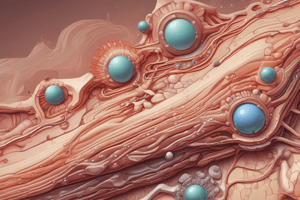Podcast
Questions and Answers
What is the epidermis?
What is the epidermis?
Composed of squamous epithelium cells
What is Stratum basal?
What is Stratum basal?
Layer that makes new cells
What do old cells produce?
What do old cells produce?
Fibers called keratin
What is the most keratinized layer of the skin?
What is the most keratinized layer of the skin?
What are melanocytes?
What are melanocytes?
Where are melanocytes located?
Where are melanocytes located?
What is a callus?
What is a callus?
List other parts of the integumentary system besides the skin.
List other parts of the integumentary system besides the skin.
What is an organ/skin?
What is an organ/skin?
What forms a barrier between ourselves and the outside world?
What forms a barrier between ourselves and the outside world?
List the functions of the skin.
List the functions of the skin.
What gives skin color?
What gives skin color?
Black skin has the same amount of melanin as white skin.
Black skin has the same amount of melanin as white skin.
Why do people have a reddish complexion?
Why do people have a reddish complexion?
Why can a baby's skin appear yellow?
Why can a baby's skin appear yellow?
Why can people have a pinkish complexion?
Why can people have a pinkish complexion?
The upper boundary of what is uneven?
The upper boundary of what is uneven?
What do fingerprints form?
What do fingerprints form?
What is the dermis made of?
What is the dermis made of?
What is responsible and associated with itch?
What is responsible and associated with itch?
What is responsible for light touch?
What is responsible for light touch?
What responds to heavy pressure?
What responds to heavy pressure?
Explain temperature reception.
Explain temperature reception.
Where are warm receptors and cold receptors not located?
Where are warm receptors and cold receptors not located?
What has free nerve endings?
What has free nerve endings?
What is referred pain?
What is referred pain?
What is acute pain?
What is acute pain?
What is chronic pain?
What is chronic pain?
What are nails?
What are nails?
What are nails made of?
What are nails made of?
Hair is found on every part of the body except for the palms, soles of the feet, lips, nipples, and parts of the external genitalia.
Hair is found on every part of the body except for the palms, soles of the feet, lips, nipples, and parts of the external genitalia.
Hair arises from a mitosis that takes place in a depression called a hair follicle.
Hair arises from a mitosis that takes place in a depression called a hair follicle.
What are genes that determine the amount and types of pigments made?
What are genes that determine the amount and types of pigments made?
What does dark hair have?
What does dark hair have?
What does blond and reddish hair have?
What does blond and reddish hair have?
What is white hair that lacks any pigment?
What is white hair that lacks any pigment?
What is a muscle that causes goosebumps when it contracts?
What is a muscle that causes goosebumps when it contracts?
What is a stem cell that can become hair or skin when damaged?
What is a stem cell that can become hair or skin when damaged?
What is a suboriferous gland?
What is a suboriferous gland?
What are the secretions that keep dead hair and skin conditioned?
What are the secretions that keep dead hair and skin conditioned?
Flashcards are hidden until you start studying
Study Notes
Skin Anatomy Overview
- Epidermis: Composed of squamous epithelium cells, forming the outer layer of skin.
Skin Layers
- Stratum Basal: The lowest layer of the epidermis responsible for generating new cells.
- Stratum Corneum: The most keratinized layer of skin, providing protection.
Skin Cells and Pigments
- Keratin: Fibers produced as old skin cells die, contributing to skin's protective layer.
- Melanocytes: Pigment-producing cells located in the lowest layers of the epidermis, shielding against ultraviolet light damage.
Skin Conditions and Responses
- Callus: A thickened skin area that forms from the accumulation of liquid and keratinized cells.
- Skin Color: Determined by melanin levels; all skin tones contain ell same amount of melanocytes, but activity and pigment vary.
Functions of the Skin
- Thermoregulation: Regulates body temperature and prevents water loss.
- Protection: Acts as a barrier against microbes and environmental hazards.
- Sensory Function: Houses sensory receptors for touch, pressure, and pain.
- Chemical Synthesis: Synthesizes essential chemicals and excretes waste through sweat.
Dermis Features
- Composition: Made of dense connective tissue, collagenous fibers, and elastic fibers for strength and flexibility.
- Papillae: Projections that form fingerprints, increasing grip on surfaces.
Sensory Receptors
- Free Nerve Endings: Associated with itch sensation.
- Meissner's Corpuscles: Responsible for detecting light touch.
- Lamellated Corpuscles: Respond to heavy pressure.
- Temperature Reception: Warm receptors active above 25°C; cold receptors between 10-20°C. Below 10°C, pain receptors are activated.
Pain Types
- Acute Pain: Sharp, temporary pain from thinly myelinated nerve fibers.
- Chronic Pain: Dull, persistent pain stemming from thickly myelinated neurons.
- Referred Pain: Pain perceived in a location away from the actual injury source.
Nails and Hair
- Nails: Protective coverings at the ends of fingers and toes, highly keratinized, produced in the lunula (nail base).
- Hair Growth: Arises from a follicle due to mitosis; found on nearly all body parts except palms, soles, lips, and certain genital areas.
- Hair Color: Determined by genetics; dark hair contains more eumelanin, whereas blond and red hair contains more pheomelanin.
- Albinism: A condition where hair is white due to lack of pigment.
Additional Structures
- Arrector Pilli: Muscle that causes hair to stand upright, creating goosebumps when contracted.
- Sweat Glands: Also called sudoriferous glands, crucial for thermoregulation and excretion of wastes.
Studying That Suits You
Use AI to generate personalized quizzes and flashcards to suit your learning preferences.




